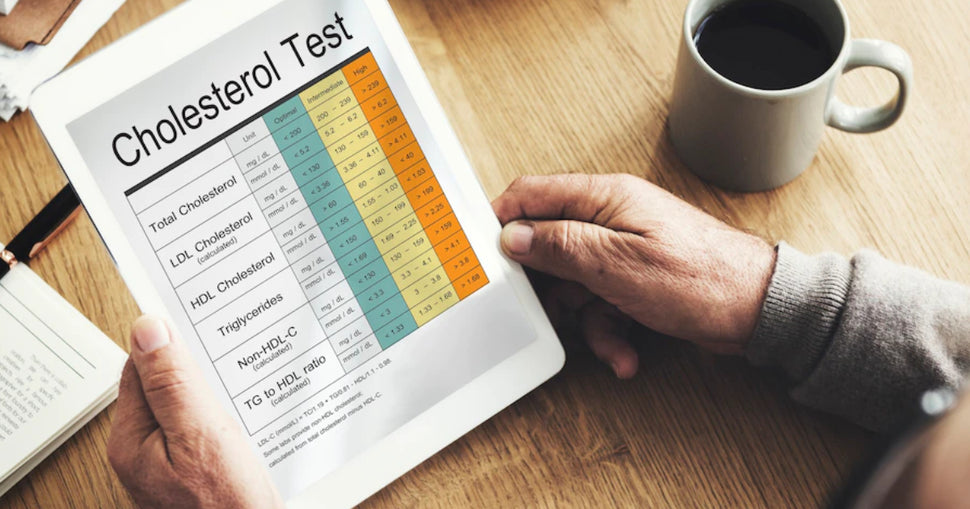Symptoms of High Cholesterol
24 Mar 2023
The liver creates cholesterol, a waxy, fat-like material. It is essential to produce various hormones, vitamin D, and cell membranes. Since cholesterol does not dissolve in water, it cannot move independently through your body.
Particles known as lipoproteins help transport cholesterol through the bloodstream. There are two significant forms of lipoproteins. Low-density lipoproteins (LDLs), also known as bad cholesterol, and High-density lipoproteins (HDLs), sometimes called good cholesterol, help return the LDL cholesterol to the liver for elimination.
Maintaining the balance between these two lipoproteins is essential for overall health. An increase in LDL cholesterol can build up fat deposits in the arteries, which results in cardiovascular and cognitive issues.
Checking for symptoms of high cholesterol becomes crucial to avert eventualities that follow.
What are the symptoms of high cholesterol?
Typically, there are no high cholesterol symptoms. The majority of the time, it only results in emergencies. For instance, the harm brought on by high cholesterol can result in a heart attack or stroke.
Usually, these things don't happen until plaque builds up in your arteries as a result of excessive cholesterol. Arteriosclerosis can make arteries smaller, restricting blood flow. Your artery lining's structure changes as a result of plaque formation. There might be severe repercussions from this.
The only method to determine if your cholesterol is too high is through a blood test. This denotes a total blood cholesterol level of more than 200 mg/dL. After you are 20, ask a doctor to check your cholesterol. Subsequently, have your cholesterol checked every 4 to 6 years again.
If you have a history of high cholesterol in your family, a doctor might advise you to have your cholesterol checked more frequently. They might also advise it if you show risk factors like high blood pressure, have issues with weight or if you smoke.
Genetics is one potential cause of high cholesterol. Familial hypercholesterolemia is a disease that results in high cholesterol that is inherited through genes. The cholesterol levels of those who have this illness are 300 mg/dL or higher. They might develop xanthoma, which can show up as a lump or a yellow patch beneath your skin.
Symptoms of various medical conditions that occur due to high cholesterol
Since there are no symptoms of high cholesterol, getting it checked periodically after you turn 20 is very important to avoid the various conditions that surface due to high LDL cholesterol levels. Though high cholesterol symptoms are almost nil, the emergencies that occur due to high cholesterol do have symptoms. Here are some of the medical conditions that emerge as a result of high cholesterol.
Coronary Artery Disease
Coronary Artery Disease is a type of cardiovascular issue. It happens when plaque accumulation narrows or hardens the major arteries that carry blood to your heart.
Men and women may experience distinct heart disease symptoms. However, heart disease can be one of the leading causes of death for both sexes. The symptoms of CAD are
- Discomfort in the chest
- Nauseous feeling
- Extremely exhaustion
- Having trouble breathing
- Back, neck, jaw, or upper belly pain
Stroke
You run a major danger of having the blood flow to a crucial portion of your brain limited or cut off due to the plaque formation brought on by high cholesterol. This is what takes place after a stroke. A stroke is an urgent medical matter. If you or someone you know exhibits symptoms of a stroke, it's critical to act quickly and seek medical attention. These signs consist of:
- Rapid loss of coordination and balance
- Abrupt dizziness
- Facial imbalance (drooping eyelid and mouth on just one side)
- Incapacity to move, especially on one side of the body
- Disorientation, or slurred speech
- Numbness, especially on one side of the body, in the face, arm, or leg
- A vision that is distorted, darkened, or double
- Acute headache that surfaces suddenly
Peripheral Artery Disease (PAD)
Plaque accumulation on the arterial walls can result in peripheral artery disease (PAD). The arteries that provide blood to your kidneys, arms, stomach, legs, and feet will be blocked as a result. Early PAD symptoms may include:
- Intermittent claudication, often known as cramping or aching, tiredness pain in your legs during activity or exercise
- It causes discomfort in your feet and legs.
If unattended, the symptoms of PAD worsen with time and can even strike while you're resting. Later signs and symptoms of decreased blood flow include:
- Gangrene, also known as tissue death from a lack of blood supply, is characterised by thinning, pallor, or shine on the skin of your legs and feet and ulcers that either don’t heal or heal slowly.
- Discomfort in your toes
- Leg cramps
- Thick toenails
- Blue-tinged toes
- A reduction in leg hair growth
- A drop in the temperature of your lower leg or foot in comparison to the other leg
Heart attacks, strokes, and limb amputations are more likely to occur in people with PAD.
Heart Attack
The accumulation of plaque can gradually cause the arteries that carry blood to the heart to constrict. Atherosclerosis is a gradual, asymptomatic process that develops over time. The plaque has a chance to fracture eventually. An area of blood clot develops around the plaque as a result. Blood flow to the heart muscle may be blocked, depriving it of oxygen and nourishment.
We refer to this lack as ischemia. It is known as a heart attack when the heart is harmed or when a portion of the heart starts to die from a lack of oxygen. Myocardial infarction is the medical term for a heart attack.
Statistics have shown that a heart attack occurs every 39 seconds. Considering the gravity of the situation, it is essential to have cholesterol levels checked periodically since there are no warning signs or symptoms of high cholesterol. However, the symptoms of a heart attack include
- Breathing issues or a sense of impending doom
- Tightness, squeezing, fullness, soreness, or aching in your chest or arms
- Dizziness
- Extreme exhaustion, nausea, or heartburn
A heart attack is an urgent medical situation. If treatment is not started during the first few hours of a heart attack, damage to the heart could become irreversible or even fatal. If you or someone you know exhibits heart attack symptoms, it's critical to act quickly and seek medical attention.
Evaluation of high cholesterol
With a blood test known as a lipid panel, high cholesterol can be quickly and easily diagnosed. Blood will be sampled by a doctor and sent to a lab for evaluation. You must fast for at least 12 hours before the test, as instructed by the doctor.
Your total cholesterol, HDL cholesterol, LDL cholesterol, and triglycerides are all measured by a lipid panel. These are the preferred amounts, according to the Centres for Disease Control and Prevention (CDC), a reliable source:
LDL cholesterol should be less than 100 mg/dL
HDL cholesterol must be at least 40 mg/dL
Triglycerides must be under 150 mg/DL
If your total cholesterol is between 200 and 239 mg/dL, it is typically regarded as borderline high. If it's greater than 240 mg/dL, it's regarded as high.
If your LDL cholesterol is between 130 and 159 mg/dL, it is typically regarded as borderline high. If it is greater than 160 mg/dL, it is regarded as high.
If your HDL cholesterol is less than 40 mg/dL, it is typically considered poor.
Monitoring cholesterol levels
If you're a healthy adult over the age of 20, then it is recommended to get your cholesterol levels checked every 4 to 6 years. If you have a higher chance of developing high cholesterol, you might need to have your cholesterol checked more frequently.
If your parents or grandparents had experienced heart attacks or other cholesterol-related issues at an early age, you might also require more frequent cholesterol screenings. If you intend to lead a healthy life, then periodic evaluation of cholesterol becomes necessary as you will not have any red signals by way of symptoms of high cholesterol. The aftermath of high cholesterol may come to you as a surprise, and sometimes it may be too late as well.
Eat well, stay active, and routinely check your cholesterol levels at your doctor’s clinic or any pathology lab to keep them in control.
Conclusion
There are no symptoms of high cholesterol, and it can be on a high without a clue. But high cholesterol can lead to major health problems if left untreated.
The only way to ensure that cholesterol levels are under control is by periodic evaluation that can be done at your doctor’s clinic or a pathology lab. Maintaining good cholesterol levels can be achieved by eating a balanced diet and exercising frequently.
Skin: Renew - Glutathione - Orange Flavour
- ₹1,996
- ₹1,996
-
₹2,600 - ( 23% OFF)
Categories
- Choosing a selection results in a full page refresh.
- Press the space key then arrow keys to make a selection.
this is the sidecart











